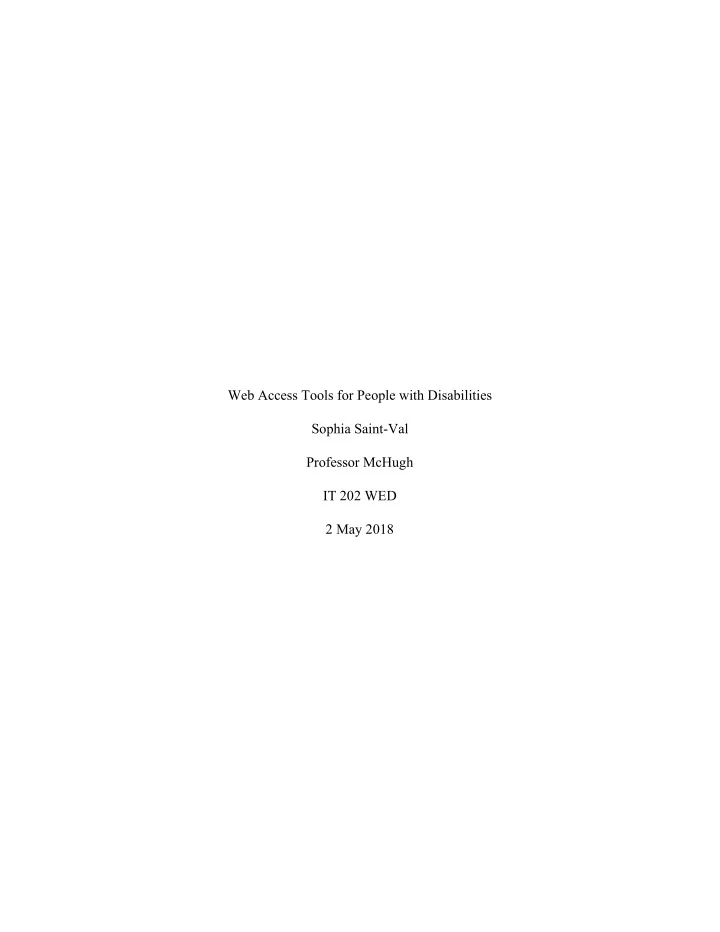

Web Access Tools for People with Disabilities Sophia Saint-Val Professor McHugh IT 202 WED 2 May 2018
Saint-Val 1 In 1997, the World Wide Web Consortium (W3C) formed the Web Accessibility Initiative (WAI). The purpose of the WAI was to establish universal standards for web accessibility. Web accessibility is a term used to describe the inclusive practice of developing websites, tools, and technologies so that people with disabilities can use them (W3.org). In order to overcome these obstacles, there have been numerous tools developed to help people with disabilities access the internet with ease. Since navigating the web primarily involves visual content, the visually impaired often find themselves unable to utilize services that people without visual impairments. For example, “mandatory use of a mouse or pointing device requiring eye-hand coordination is a problem” for people with visual impairments (W3.org). Most web browsers also allow users to be able to change the color schemes of text, backgrounds and change fonts to styles that are easier on the eyes. People who are visually impaired, but not blind can use screen magnifiers to view information on their computer screens (Monsido.com). In addition to display modifications, the visually impaired can utilize screen readers to help them navigate the internet. Screen readers “give visually impaired people options to easily control what is read, such as by finding strings of text on the screen, reading just a line of text, or reading just text in bold or certain color text” (Monsido.com). Popular examples of screen readers include COBRA, Hal, JAWS, and Google Talk Back (Google.com). People with visual impairments can also use braille keyboards to navigate the web. Braille keyboards can comprise of 8 keys used to compose Braille letters or standard QWERTY keyboards with braille letters overlaid on them (Monsido.com). People who live with physical disabilities might experience difficulties when using programs that “require a response in a specified period of time, especially if it is short” and
Saint-Val 2 therefore might have difficulty using pointing devices, such as computer mice (Varghese 29). To combat these obstacles, people with physical disabilities can turn to sip and puff systems to access their computer. A sip and puff system allows a person to control cursor movement using a straw. Another useful tool is hands-free mouse tracking, which allows physically-impaired individuals to control their cursor without a mouse or keyboard. Examples of hands-free mouse tracking software include FaceMouse, Lomak, and the EyeGaze Edge system (Monsido.com). People who are deaf or hearing impaired can interact with content on the web using avatars or digital signers, which are “digitally created characters that turn speech into sign language” developed under the eSign project(AbilityNet.org). Other tools at their disposal include closed captioning services or text transcripts that often accompany audio and video content on the Internet (W3.org). Web developers can make an effort to incorporate the needs of people with disabilities into their design process by putting meaningful ALT text on images, spacing buttons well apart so it is easier for people using hands-free mouse tracking to aim, and use color and other visual indicators to convey messages. Developers should also use themes and templates that provide notes and guidelines to make web pages more accessible, organize content using headings to help screen readers navigate more smoothly, and give web links unique and descriptive names (UC Berkeley). All of these tips are easily to incorporate into the design and development processes and go a long way in terms of inclusion. Unfortunately, most countries do not have laws set in place to enforce web accessibility, so accessing the internet comes with many obstacle for people with disabilities around the world. Perhaps in the future there will be laws that mandate that all web pages must abide by the
Saint-Val 3 procedures outlined in the WAI so everyone can enjoy the Internet with ease. Until then, we can only hope for new innovative technologies that will help people with disabilities in the meantime. Works Cited “7 Tech Tools Which Help People With Disabilities Access the Internet.” Monsido.com , 19 Oct. 2016, monsido.com/tech-tools-web-acessibility-for-disability. This article lists and describes seven examples of tools used by people with a variety of disabilities to overcome the obstacle limited web accessibility.
Saint-Val 4 Arch, Andrew, et al. “Better Web Browsing: Tips for Customizing Your Computer ◦ Web Accessibility Initiative.” Edited by Shadi Abou-Zahra, W3.org , World Wide Web Consortium, 24 Aug. 2010, www.w3.org/WAI/users/browsing#reading. This document from the official page of the Web Accessibility Initiative provides references to resources, including detailed documentation and step-by-step guides, to help with web browser and computer setup. “Avatars – Digital Signers.” My Computer My Way , AbilityNet.org, mcmw.abilitynet.org.uk/avatars-digital-signers/. This article explains how digitally created people known as ‘avatars’ are bringing sign language to the web, digital TV and other applications in order to help those with hearing impairments access these services. “Use TalkBack to Browse the Web with Chrome.” Google Chrome Help , Google.com, support.google.com/chrome/answer/2633135?visit_id=1-636604387045958679-48652 206&rd=1. This article is an official tutorial on how to use Google's Talk Back application, which allows users to use the web without having to look at a screen. “Top 10 Tips for Making Your Website Accessible.” Berkeley Web Access , UC Berkeley, webaccess.berkeley.edu/resources/tips/web-accessibility. This article provides web developers tips on how to make sure that their websites are accessible to people with disabilities. Varghese, Sharon. “Application of IoT to Improve the Life Style of Differently Abled People.” IOSR Journal of Computer Engineering (IOSR-JCE) , pp. 29–34., doi:101695062.
Saint-Val 5 This article analyses the living environment of people who live with sensory and physical disabilities and presents how the Internet of Things (IoT) can help them to overcome difficulties their disabilities can create.
Recommend
More recommend